Dr. Robert H. Greg II, DDS highlights how QuickSplint® aids in post-op healing and keeps the teeth stable and out of occlusion.
Save 20% on all QuickSplint® orders when you use code LANAP


US Based Company

Same Day Shipping

Satisfaction guaranteed
1. Worn overnight post-operatively, QuickSplint® keeps the teeth stable and out of occlusion while protecting the gums and fibrin clot
2. QuickSplint® is comforting and assuring to the patient and helps promote healing
3. QuickSplint® contributes to recovery of jaw muscles and joints and can be used to address jaw fatigue
1. Prior to starting LANAP® surgery, the dental auxiliary fabricates a QuickSplint® for the patient and readies the QuickSplint® in the carrying case along with the “Healing with QuickSplint®” patient instructions.
2. After LANAP® treatment, along with other post-op instructions, direct the patient to wear QuickSplint® every night as protection for teeth and gums and to help the jaw relax and recover. Instruct the patient to wear QuickSplint® every night until their next follow-up appointment and bring the QuickSplint® to their follow-up appointment.
3. During the follow-up appointment, examine the QuickSplint® for signs of wear. Wear marks from clenching and bruxing are recording on the QuickSplint®. Use this information in your determination of a long-term appliance.


QuickSplint® is highly retentive but also flexible enough not to put orthodontic force on the teeth. It will last for several weeks and can be relined for staged treatment.
QuickSplint® can be used on the upper or lower arch.
Fill heavy-body VPS to the top of the tray, place it over patient's teeth and instruct them to gently bite together. Hold in place until the material sets.
Trim excess VPS with a scalpel, end to end.
Instruct the patient to try the QuickSplint® so you can check retention and again ensure there is contact on both sides but not with the back teeth. Once you have verified the fit, you have completed the fabrication of the QuickSplint®.
Vinyl Poly Siloxane (VPS) and the seating recommendations allow for a self-leveling bite plane in the anterior region that allows the mandible to move freely. This design can also reduce the pressure within the temporomandibular joints.
For acute jaw pain, QuickSplint® is used to facilitate masticatory muscle relaxation and reduce pressure in the inflamed joint complex. Reduction of muscle tension functions to quiet the pain process by dampening pain pathways.
For post-operative dental procedures, disclusion of the teeth prevents direct coronal trauma during the healing phase. QuickSplint® immediately removes potential occlusal trauma, giving the instrumented tooth time to heal from apical inflammation. In the case of periodontal and implant procedures, QuickSplint® may encourage soft tissue or bone healing by avoiding occlusal trauma or pressures.
Distribution of bite force also protects crown and veneer temps.
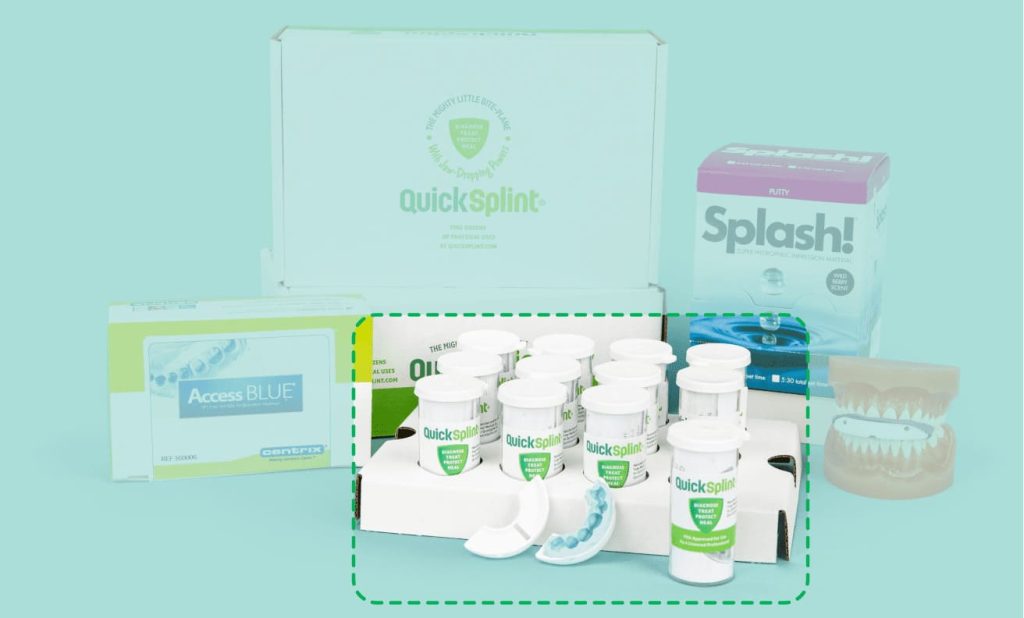
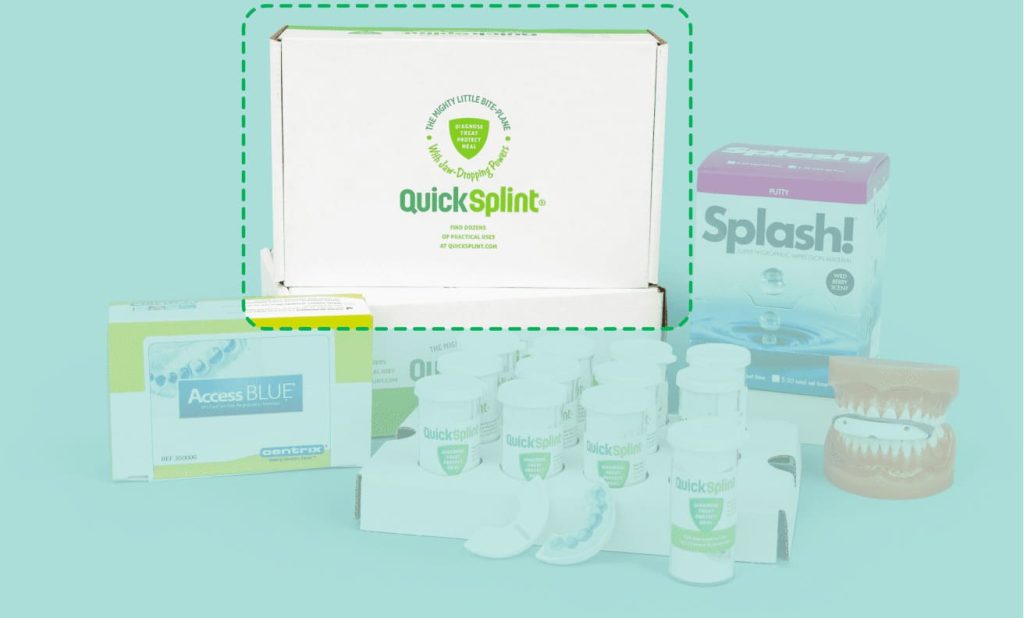
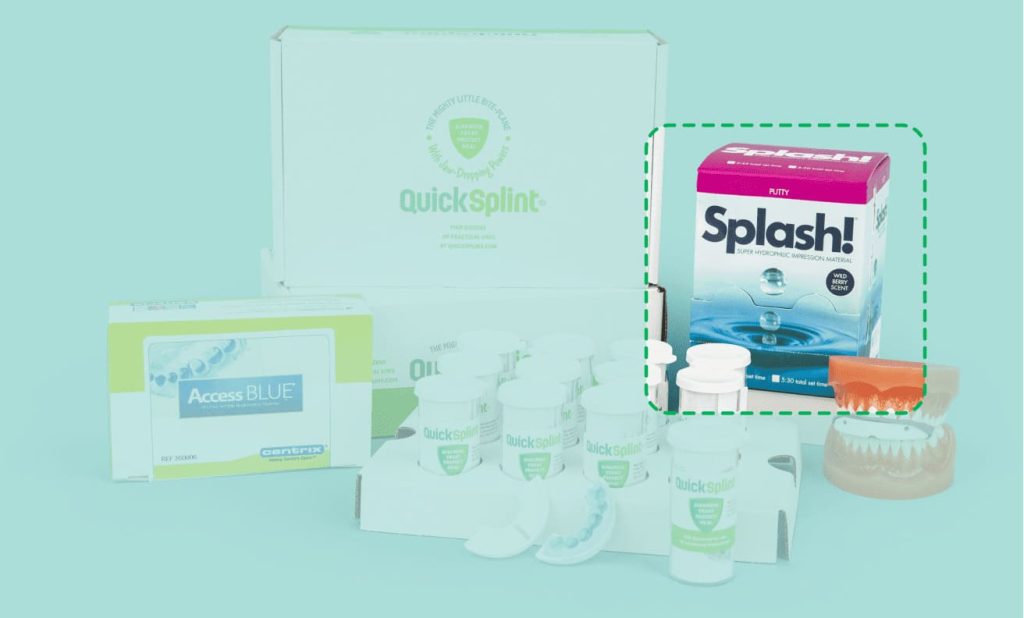
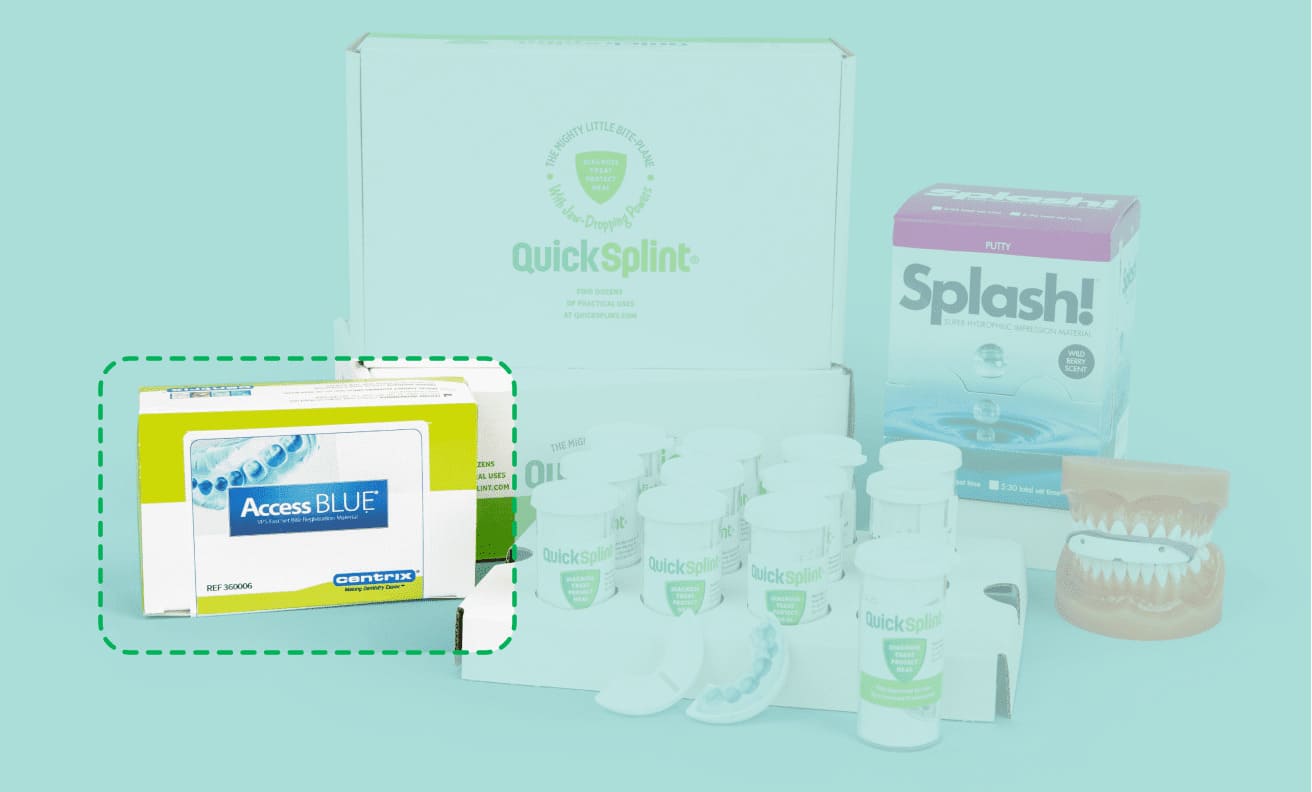
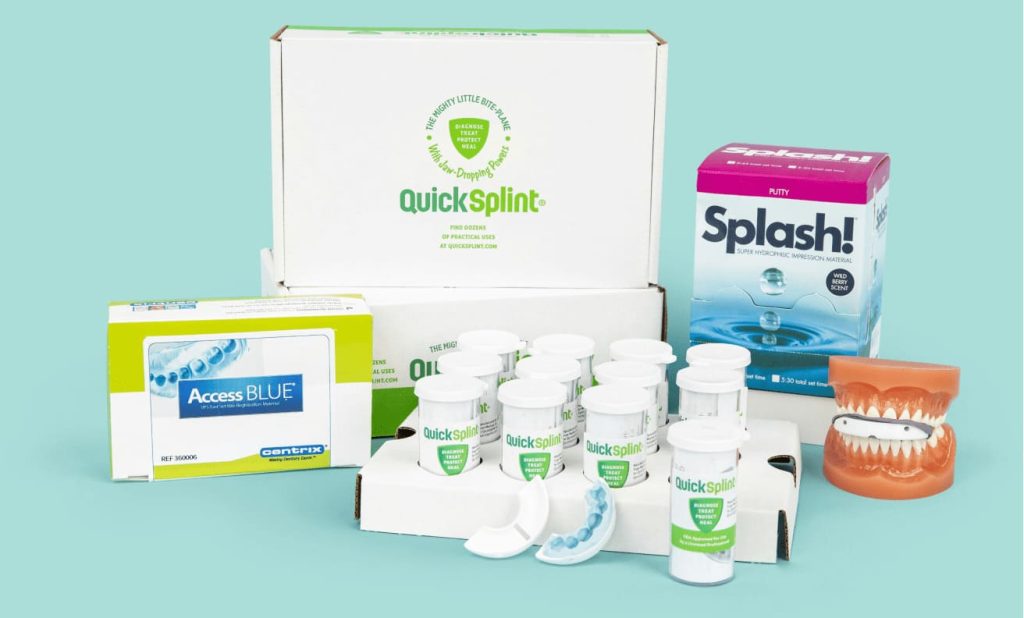






QuickSplint® provides practice teams with an immediate way to relieve jaw pain and get patients on the path to healing. Here are some real-life scenarios where QuickSplint® can be a powerful clinical solution.
Scenario: Tight schedule and patients presenting with jaw pain.
You have seen 30 patients today and three patients present with jaw complaints. You don't have time to fully evaluate each case, nor do you feel confident that you will be able to retain the level of detail each one presents, given all that's happened today.
Scenario: Patient has an acute flare up again.
The patient wants pain relief. In the back of your mind, you can visualize how hard she is clenching as she is talking about her condition. You can see her today, but you can’t deliver a new custom splint like the one she stopped wearing last year. Her jaw needs a little rest and she needs to retrain certain oral habits, and she needs it today before she gets worse.
-OR-
Scenario: Patient calls, he can barely open his jaw today.
The patient was referred to you by your favorite colleague, and his endo surgery yesterday went well. The patient filled the pain med prescription, but today he can barely open his jaw. He wants to know what to do and he sounds freaked out.
Thankfully, your staff knows what to do. From the front desk, to treatment coordinator, to dental assistant, they all do their part to encourage the patients to start treatment with QuickSplint® temporary bite plane.
Leading dentists use QuickSplint® to minimize the risk of jaw injury during dental procedures and help the jaw relax and recover post-operatively. Here are a few examples of how QuickSplint® can be utilized to provide an extra measure of care for higher-risk patients.
Scenario: Posterior crown prep was hard the last time.
You and your staff remember last year, when the patient couldn’t keep her jaw open during crown prep on #18. She had limited range-of-motion to start, and she wanted breaks and looked anxious about the time it was taking. She is scheduled for a crown prep on #19 this week, and she told your staff she dreads the procedure.
-OR-
Scenario: High-risk patient.
Your treatment coordinator is with the patient, scheduling two appointments for scaling and root planing, with the second appointment two weeks after the first. The treatment coordinator has the patient fill out the JAMSS Risk Assessment Questionnaire; she spots red flags in the patient’s responses.
Scenario: Signs of jaw fatigue.
A young woman has her first root canal. She was nervous and highly agitated before the procedure. There were some signs of jaw fatigue during the RCT. Do you manage the risk of sudden onset of jaw pain now, or see what manifests? You don’t want to cause alarm or worry.
Send your patients home with an immediate, comfortable overnight solution to protect their teeth and new dental work and prevent tooth, jaw and facial pain. Use of QuickSplint® minimizes possible complications, such as coronal trauma, jaw sprain, dislodged veneers, and helps smooth transitions in staged treatment.
Scenario: Patient wants perfect anterior veneers.
She is a delightful patient willing to pay for perfection. You have selected materials that will perform well under the stress of her parafunctional behavior. However, she is a fierce clencher and there’s a chance that she is going to knock off her provisionals when she is on her high stakes business trip next week. Trip timing is not ideal. There have been other instances where she has come back for a re-do.
Scenario: Wrapping up an Invisalign case.
The patient is happy with her bite and new look. She’s one of those patients that wanted to analyze all the options. She is a value investor type and believes that it’s worth paying for Invisalign if the results are lasting.
Scenario: Performing periodontal laser treatment with the LANAP® Protocol.
Your patient has severe gum disease and wants minimally invasive treatment. He’s a good candidate who seems determined to improve his oral health that he previously neglected.
Everything you need to know about the Home Healing Kit. Can’t find the answer you’re looking for? Please write questions to us at info@quicksplint.com
QuickSplint® is a conservative first step in the diagnosis and treatment of acute jaw pain and/or bruxism. Some dentists will modify the QuickSplint® for patients with a small arch. It is not recommended for patients with missing teeth, hypermobility, or a history of joint problems. Read all instructions prior to prescribing.
QuickSplint® is FDA 510k cleared for short-term treatment of TMD pain and associated headache and bruxism, and for protection of dental restorations. QuickSplint® is patented, and made in the USA.
QuickSplint® can be fit for either upper or lower arch. We recommend that you identify which arch has greater tooth contact and make QuickSplint® for the opposing arch. This is because the VPS will fill in to support the dentition.
QuickSplint® is a type of mouth guard designed for short-term use of up to six weeks, or under the care of a dentist. Over a longer period of time, there is the possibility that your back teeth can shift and create an “open bite”.
If QuickSplint® has been helpful to you and you would like to continue wearing a mouth guard when you sleep, this is helpful information for your dentist to consider transitioning you to a long-term oral appliance customized to your needs. Not all mouth guards have the same functional purpose. Consider using our provider directory to find a dentist who specializes in splint therapy (treatment with oral appliances).
QuickSplint® is to be used primarily when sleeping to prevent pain or damage to teeth (or restorations) caused by nighttime occlusal forces. The prescriber may suggest that QuickSplint® be worn during the day as well for pain relief or to promote healing from surgical procedures, such as periodontal surgery, implant placement, and third molar extraction. QuickSplint® is not recommended for continuous daytime wear of over two weeks.
QuickSplint® temporary oral appliance has two components: A) a rigid biocompatible plastic shell and B) an insert of fast-set Poly Vinyl Siloxane (VPS) impression material to customize each appliance to supporting dentition.
Patients can clean QuickSplint® daily by rinsing thoroughly under tap water. Dry the QuickSplint by shaking the excess water from the surface and allow to air dry. When needed, clean QuickSplint® using an ultra-soft toothbrush or by gently washing with water. Patients may periodically disinfect their QuickSplint® by soaking in a half and half mixture of mouthwash and water for ten minutes. Do not clean QuickSplint® in boiling water, denture cleaner, or soak it in hydrogen peroxide.
Patient instructions for use are included within the QuickSplint® storage container. Or, they can access the patient instructions online via our Downloads page. Patient instructions indicate that QuickSplint® is designed for short-term use only.
QuickSplint® temporary oral appliance may not be suitable for all patients. QuickSplint® should be used with care in patients with jaw mobility of less than 25mm or greater than 60mm. QuickSplint® should not be fit on or over broken or loose teeth.
QuickSplint® temporary oral appliance can be used for dental emergencies and acute pain as it relates to TMD, sprained jaw, tension headache, or other facial pain. QuickSplint® is also an effective emergency splint for the patient who has lost their appliance and needs an occlusal guard while a new one is being fabricated. QuickSplint® is not for emergencies involving broken teeth or trauma. Never fit QuickSplint® temporary oral appliance over loose or broken teeth. Read complete product instructions before use.
If the soft lining material disengages from the tray, the patient is advised to return to their prescriber for replacement of the liner. They should not attempt to glue the liner to the tray.
Dental practices can purchase QuickSplint® directly via our online store, through one of our distributors, or through Amazon.
If the patient experiences joint pain on loading, this is an indication that the patient may have a joint issue. Use of the QuickSplint® should be discontinued and further examination is required. Patients who have a major shift in their occlusion can experience mandibular repositioning, resulting in the inability to find their old habitual position.
